Narrative and photo contributed by: Charles Anthony Mantlow and Diana Ricci.
Anchor Hocking Glass
Here you will find a chart that is a chronological timeline that covers the history of the Anchor Hocking Glass Company from it's beginning in 1905 to the present, as well as, a summary pic of each pattern currently represented in the Glass Lovers Glass Database.
Translate
About Anchor Hocking

Anchor Hocking Timeline Chart
About Glass Lovers Glass Database Company Blogs
The Glass Lovers Glass Database is made up of glass patterns by Company by Country. Within the database there are many pieces shown for a particular pattern and, in many cases, multiple views of a piece. For example, a bowl could have one design on the front and another design on the back; therefore, there would be two pics of that particular piece. Here, we will only show one piece per pattern name or pattern number.
Above you will find a chart that is a chronological timeline that covers the history of the Anchor Hocking Glass Company from it's beginning in 1905 to the present. During such a long time span, it is understandable how the company made just about every type of glass conceivable. Some categories that Anchor Hocking made are under-researched and others; like depression glass have numerous references on the net. Here we attempt to catalog all categories of glass by pattern name or number that the company ever made from Early American Pattern Glass to Depression Glass to Modern 21st Century Glassware thus providing a complete catalog history of the Company patterns as best we can over time.
I will be adding blog pages for every company in the database in this same manner with just one image per pattern with information about the pattern depicted. Feel free to leave comments critiquing and/or adding information to enhance this blog and our database. We do not guarantee that all this data is complete or totally accurate. All comments will be reviewed by our experts as they are received. This data is only as good as humanly possible given the enormous project we are undertaking.
Be sure to track my blogs every day or so since it will take some time to develop these pages. I hope to add information daily until the blogs comprise a summary of the over 10,000 glassware images currently in our database.
Thank you for visiting!
Above you will find a chart that is a chronological timeline that covers the history of the Anchor Hocking Glass Company from it's beginning in 1905 to the present. During such a long time span, it is understandable how the company made just about every type of glass conceivable. Some categories that Anchor Hocking made are under-researched and others; like depression glass have numerous references on the net. Here we attempt to catalog all categories of glass by pattern name or number that the company ever made from Early American Pattern Glass to Depression Glass to Modern 21st Century Glassware thus providing a complete catalog history of the Company patterns as best we can over time.
I will be adding blog pages for every company in the database in this same manner with just one image per pattern with information about the pattern depicted. Feel free to leave comments critiquing and/or adding information to enhance this blog and our database. We do not guarantee that all this data is complete or totally accurate. All comments will be reviewed by our experts as they are received. This data is only as good as humanly possible given the enormous project we are undertaking.
Be sure to track my blogs every day or so since it will take some time to develop these pages. I hope to add information daily until the blogs comprise a summary of the over 10,000 glassware images currently in our database.
Thank you for visiting!
ACCENT MODERN by Anchor Hocking
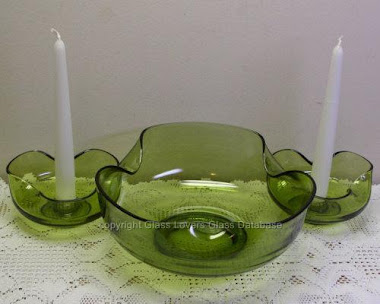
This is a console set, consisting of a 9" glass bowl & 2 candlesticks from Anchor Hocking in the "Accent Modern" pattern and their Avacado color. A very retro look with modern mid-century styling. The bowl is 3 3/4" deep, about 9" across.
Photo Contributed by: PrettyCurious
BANDED RINGS aka Ring by Anchor Hocking / Hocking Glass
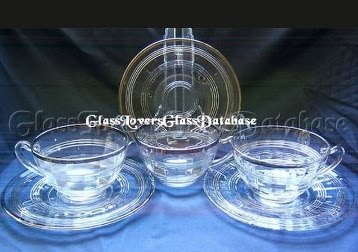
Hocking Glass (now Anchor Hocking) made Banded Rings also called Rings between 1927-1933. It is similar to Circle, another AH pattern. The main difference is that circle can have anywhere from four to nine rings while Banded Rings always has only four. The original colors issued were green, crystal, a multi-colored variation and crystal with a platinum rim. Later issues included many different color rings. Some of the tumblers can also be found in pink.
The pieces shown here have the platinum band around their rims.
Photo contributed by: Eileen, GLGD member glassie49
BERWICK aka Boopie by Anchor Hocking
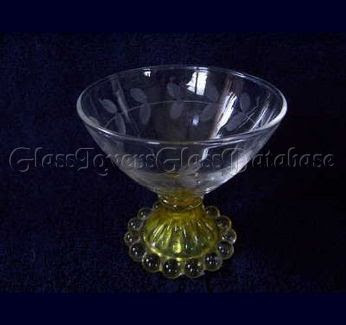
Berwick aka Boopie was made from 1950s until the 1970s.. This is a 'go-with' pattern created by Anchor Hocking. It goes with the Bubble pattern. Has a single row of bubbles (like candlewicks) around the bottom edge of foot; straight lines down from the top of the foot and circling at bottom and then straight up to top of foot. Came in Forest Green, Royal Ruby, Amber and Crystal. This one happens to be decorated with laurel leaves in a cut design. Not all Berwick or Boopie in this form is decorated like this one.
Photo contributed by: luvdem goaties - Deb - GPSA
BLOCK OPTIC aka Block by Hocking Glass
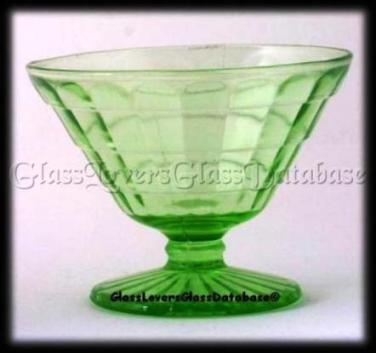
Block Optic, also called Block, was produced by Hocking Glass from 1929-1933. It was a popular pattern because it was not costly and often given away during the depression years. It was advertised as being thin blown glassware and many collectors enjoy its lightness. Originally issued in green, crystal, pink and yellow. Green is the most plentiful and yellow the least. Topaz dates from 1931. The sugar and creamer have been found with a satin-finish frosting called Clambroth. There is one blue butter dish as of 1988. Footed and stemmed pieces were also made with black stems and feet. These include tumblers, goblets and sherbets. There is a remarkable amount of the differences in the pattern. As stated above, it was made with black footed stems as well as the green. There are five variations of sugars and creamers. Some because of their handles, their being flat or footed, and some with rays while others have plain bottoms. Again, some pieces were satin-ized or frosted. Both the yellow and green fluoresce under a black light. There are two sizes of water goblets, but both hold 9 ozs.
Reference:
The Official Price Guide to Depression Glass, 2nd Ed., 1986 House of Collectibles
Photo contributed by: GLGD Helen's Catisfaction Ruby Lane Store
BUBBLE aka Bullseye aka Provincial by Hocking Glass / Anchor Hocking

This pattern was made from 1934 thru 1965 and was sold under several names. The first item issued was a pink bowl called Bullseye in 1934. A table setting in crystal was offered in 1937 and heat proof Fire-King pieces in light blue were made from 1942 to 1948. Differing dates have been reported for a dark Forest-Green but it was probably made in 1954.
The same pattern, this time referred to as PROVINCIAL, was made in milk white in 1959 and then in royal ruby in 1963 thru 1965.
Collectors, however, know this pattern exclusively as Bubble. The main colors were made in crystal, dark green, light blue, ruby red and a very small amount of pink. Pieces in almost every color Anchor Hocking used have been reported but these are exceptional and are not very collectible.
The pattern is made up of an overall series of raised bubble-like shapes in horizontal rows. A rayed design is contained within the circular center of the bowls and plates. The edges are scalloped, except for the cups. The flange-edged bowls are rare as are many of the light blue pieces. Crystal sells for about half of the price of the blue.
Reference:
Official Price Guide to Depression Glass, 2nd Ed, 1986 The House of Collectibles
Photo contributed by: GLGD's krystal347.
BURPLE by Anchor Hocking
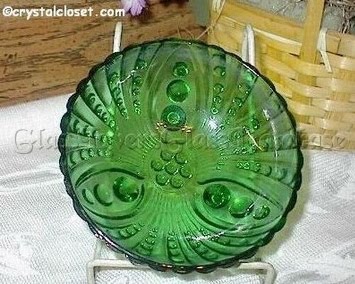
1940's-1970's. Burple is made in amber, royal ruby (red), forest green and clear. Red is the rarest. You'll find clear stems on footed stemware, as well, as cuttings and etchings. Barware can be found with gold band rims. The stemware is called INSPIRATION.
This bowl was made during the 1940s. 4 1/2 inches wide. A small dessert set consisting of two sizes of bowls.
Photo contributed by GLGD's krystal347.
CAMEO aka Ballerina or Dancing Girl by Hocking Glass

CAMEO aka Ballerina or Dancing Girl by Hocking Glass Cameo also known as Ballerina and Dancing Girl. Made from 1930-1934. This pattern has been reproduced. The miniature piece with the Cameo design are being made by the Mosser Glass Company The original name of this pattern made by Hocking Glass was Cameo but it is also known as Ballerina and Dancing Girl. It was Hocking's first mold-etched ware and was made from 1930 to 1934. Some pieces are styled from Block Optic which explains the resemblance between the candy jars, creamers and sugars, wine glasses and goblets and the ice tubs in the two patterns. Two years after Cameo's introduction, the style of the creamer and sugar and cup handles changed so there are two versions on these. A cable design appears on the rim of some pitchers while other rims are plain. Colors made by Hocking are green, yellow, pink, and crystal with a platinum rim. Topaz (yellow) was added in 1932 but not all the pieces were made. Flamingo (pink) is the hardest to find and can be quite costly. The following pieces are rare; the yellow and green lidded butter dish, the pink 4 inch covered candy jar, the crystal lidded cocktail shaker, the 3-1/2 inch green cordial goblet, the pink and crystal 5-1/2 inch ice bowl, the footed 7-1/2 inch pink salt and pepper shaker, the yellow 20 oz, 5-3/4 inch syrup pitcher, and the 4 inch pink wine goblets. Many more are becoming very hard-to-find. This pattern has been reproduced. The miniature piece with the Cameo design are being made by the Mosser Glass Company. The salt shakers were reproduced but the new ones are easy to spot. The pattern is weaker, there is more glass on the bottom and the tops are brand new. The children's dishes are also new, but since none were made originally, they are also no problem to detect. Written by: Diana Ricci and Charles Mantlow
Saturday, July 6, 2013
CORONATION aka Banded Rib aka Saxon by Hocking Glass Company
This Hocking Glass Coronation pattern was produced in 1936 to 1942 to commemorate
the Coronation of King Edward VII. It is a small pattern with not many
pieces and forms produced. It comprises finely mitered ribbing in a banded design on top of wide ribbed panels on the bottom. The bottom of the pieces has a finely mitered ray and where there are handles they are also ribbed. Other names it goes by are Banded Rib, Banded Fine Rib or Saxon. It can
be found in it's main colors of pink and royal ruby, some crystal or crystal with gold trim, and a small amount of
green. There are no red saucers; the red cups were sold with crystal saucers. A common mistake by collectors is to confuse the Coronation tumblers with Lace Edge tumblers. They are similar but the ray design goes further up the side of the glass than on the Lace Edge tumblers. On Lace Edge, the ray design only covers about 1/3 of the glass.
Narrative and photo contributed by: Charles Anthony Mantlow and Diana Ricci.
Narrative and photo contributed by: Charles Anthony Mantlow and Diana Ricci.
Saturday, June 29, 2013
CIRCLE by Hocking Glass, Circa 1930-1935
During the 1970's
green was the only color that you could collect into sets but now more and
more pink is showing up. Some of the early catalogs has crystal listed. Some of the pieces have the center ray design and some do not but it's
still Circle. Some of the stems are crystal with the green tops. This
pattern has two styles of cups. Flat-bottomed and rounded. The
flat-bottom fits the saucer/sherbet plate, while the rounded bottom fits
an indented saucer.
Ref: Official Price Guide to Depression Glass, 2nd Ed., by The House of Collectibles
* The Hocking Circle Green Lucheon Plate below is 8.5" in diameter. The image was contributed by: FanofFenton Sarah - GPSA
* The green sherbet below is 4 3/4 inches high and the photo was contributed by: roxannesebastian Monica - GPSA
Ref: Official Price Guide to Depression Glass, 2nd Ed., by The House of Collectibles
* The Hocking Circle Green Lucheon Plate below is 8.5" in diameter. The image was contributed by: FanofFenton Sarah - GPSA
* The green sherbet below is 4 3/4 inches high and the photo was contributed by: roxannesebastian Monica - GPSA
CATHEDRAL aka Floral and Lattice by Hocking Glass, Circa early 1930's
Cathedral aka Floral and Lattice by Hocking Glass is a beautiful scarce and distinctive pattern. This really hard-to-find pattern was produced for a very short time by Hocking Glass in the early 1930's. It was made in dessert or salad plates only (not a full table service). A dessert or luncheon set of plates can be collected though not easily. The center area of the plate has a radiating floral, a rose window pattern like those in stained glass windows in cathedrals like Notre Dame. I have seen plates in both green and pink.
Top Photo contributed by: Marcet - Blissfulthings - GPSA; Bottom Photo contributed by Diana Ricci
Top Photo contributed by: Marcet - Blissfulthings - GPSA; Bottom Photo contributed by Diana Ricci
Sunday, September 12, 2010
My First Post
I hope you all enjoy the Anchor Hocking Blog! If you should have any questions, don't hesitate to ask.
Subscribe to:
Posts (Atom)




